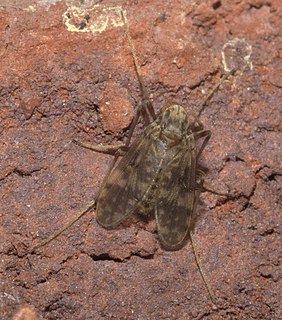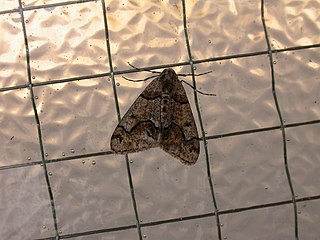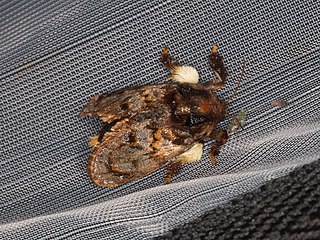
The Culicinae are the most extensive subfamily of mosquitoes (Culicidae) and have species in every continent except Antarctica, but are highly concentrated in tropical areas. Mosquitoes are best known as parasites to many vertebrate animals and vectors for disease. They are holometabolous insects, and most species lay their eggs in stagnant water, to benefit their aquatic larval stage.

Psectrotanypus is a genus of non-biting midges in the subfamily Tanypodinae of the bloodworm family Chironomidae. Psectrotanypus varius is known to occur in very polluted waters with only few other accompanying species such as Chironomus plumosus.
Mansonia mosquitoes are big, black or brown mosquitoes with sparkling on their wings and legs. They breed in ponds and lakes containing certain aquatic plants, especially the floating type like Pistia stratiotes and water hyacinth. The eggs are laid in star-shaped clusters on the undersurface of leaves of these plants. The larvae and pupae are found attached to the rootlets of these plants by their siphon tubes. They obtain their air supply from these rootlets. When about to become adult, these pupae come to the surface of water and the fully formed adults emerge and escape. The control of Mansonia mosquitoes is easy by removal or destruction of the aquatic host plants by herbicides.

Gabriola dyari, or Dyar's looper, is a moth of the family Geometridae first described by Taylor in 1904. It is found from the Alaskan panhandle and British Columbia to California. The habitat consists of coniferous forests.
Azaxia dyari is a moth of the family Notodontidae. It is found in Costa Rica.
Mansonia (Mansonioides) annulifera is a species of zoophilic mosquito belonging to the genus Mansonia.
Mansonia indiana is a species of zoophilic mosquito belonging to the genus Mansonia. It is found in Sri Lanka, Java, India, Myanmar, Malaya, Singapore, Sumatra, Thailand, and New Guinea. It is a vector of nocturnally subperiodic Brugia malayi. Females are known to be strongly anthropophilic. Larvae found only in association with Pistia species.
Mansonia (Mansonioides) uniformis is a species of zoophilic mosquito belonging to the genus Mansonia.
Agapema anona, commonly known as the greasewood silkmoth or Mexican agapema, is a species of giant silkmoth in the family Saturniidae.

Psectrotanypus dyari is a species of midge in the family Chironomidae.

Sphecomyia is a genus of hoverfly in the family Syrphidae. There are about 16 described species in Sphecomyia.
Stiria dyari is a species of moth in the family Noctuidae. It is found in North America.
Deinocerites is a genus of mosquitoes in the family Culicidae. There are about 18 described species in Deinocerites.
Mansonia titillans is a species of mosquito in the family Culicidae.

Phobetron is a genus of slug caterpillar moths in the family Limacodidae. There are at least four described species in Phobetron, found in North, Central, and South America.

Mansonia is a genus of flowering plants. It includes five species of large evergreen or deciduous trees. The species are native to tropical Africa and southeastern Asia.

Mansonia altissima is a species of tree native to western and Central Africa.
Mansonia gagei is a species of flowering plant in the family Malvaceae. It is found in Southeast and South Asia.
Mansonia is the scientific name of two genera of organisms and may refer to:






